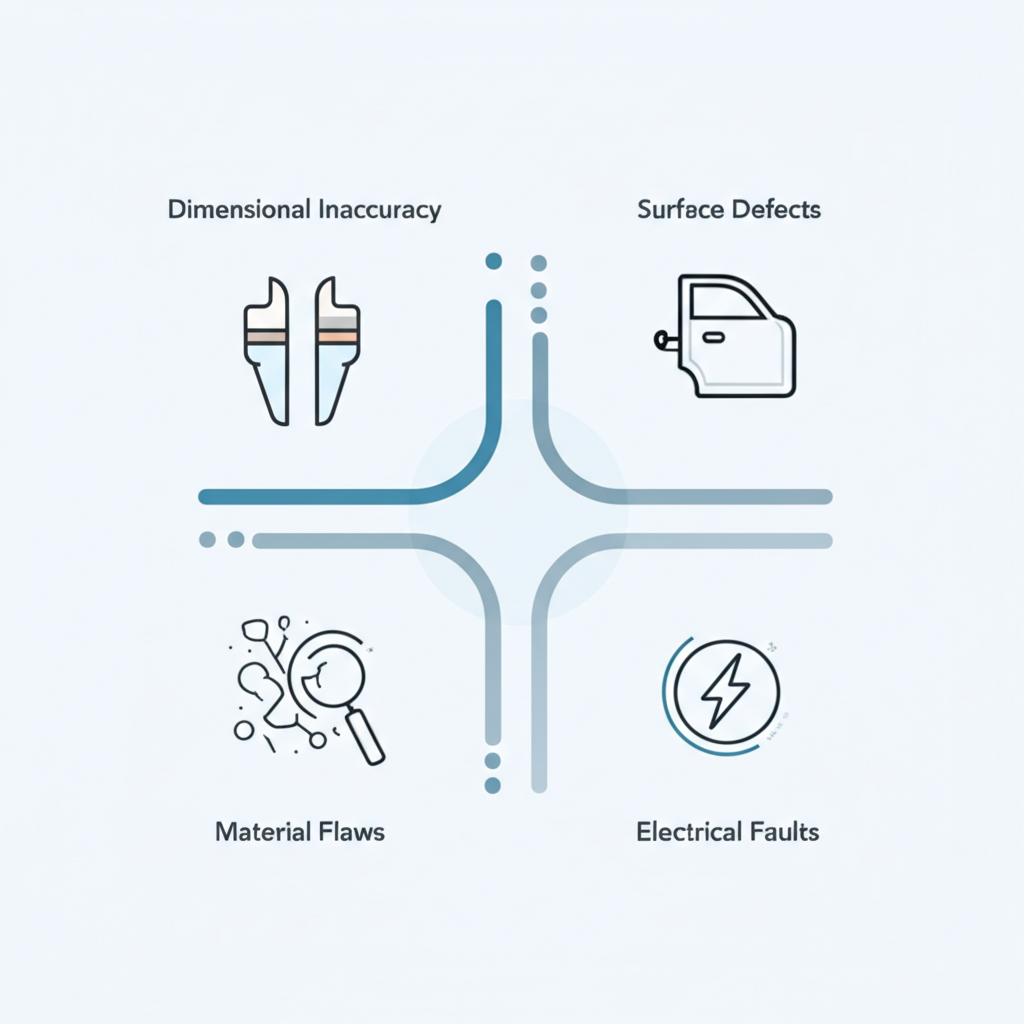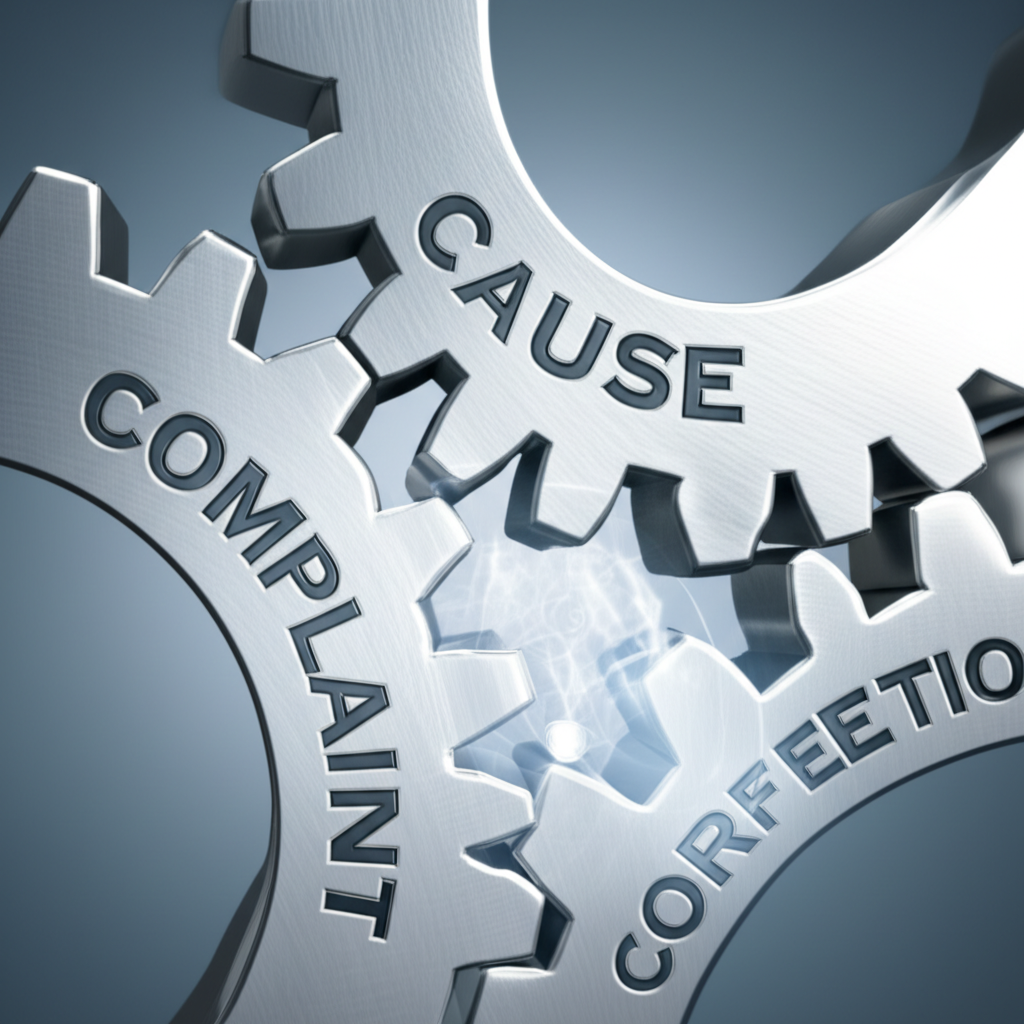A Guide to Troubleshooting Common Automotive Assembly Issues

TL;DR
Troubleshooting common issues in automotive assemblies requires systematically identifying and diagnosing a range of quality control failures. Key problems include dimensional inaccuracies, material defects, surface imperfections, and complex assembly errors, which often originate from process flaws, inconsistent materials, or human error. An effective approach involves categorizing failures, understanding root causes like process variability, and implementing a structured diagnostic framework to move from reactive fixes to proactive prevention.
Categorizing the Most Common Assembly Failures
In the highly complex world of automotive manufacturing, quality control is paramount. A single defect can compromise safety, performance, and brand reputation. Understanding the primary categories of assembly failures is the first step in effective troubleshooting. These issues can be grouped into several key areas, each presenting unique challenges for production lines. By breaking down problems into logical categories, teams can develop more targeted and effective solutions.
One of the most frequent challenges is dimensional inaccuracy, where components deviate from their specified measurements. This can stem from variations in machining, material properties, or the assembly process itself. When parts do not fit together as designed, it can lead to misalignments, functional failures, and even safety hazards. Another significant category is material defects, which includes metallurgical flaws, porosity, or inclusions within the raw materials. These defects compromise the structural integrity of components and can be difficult to detect without rigorous inspection protocols. Even high-quality designs can fail if the underlying materials are flawed.
Surface and coating defects also represent a major area of concern. These issues, such as scratches, dents, paint runs, or improper coating adhesion, affect both the vehicle's aesthetic appeal and its long-term durability against corrosion. Finally, electrical and electronic failures are increasingly common as vehicles become more technologically advanced. Problems with wiring harnesses, sensors, or control modules can lead to malfunctions that are often difficult to trace back to a single source. Common examples of these failures include:
- Assembly Errors: Incorrectly installed components, missing fasteners, improper torque settings, or faulty welding.
- Surface Imperfections: Scratches, dents, blemishes, or uneven paint coverage that detract from appearance and protection.
- Material Flaws: Inclusions, porosity, or other weaknesses in raw materials that compromise component strength and longevity.
- Electrical Faults: Poor soldering, defective connectors, or design flaws in electronic systems leading to functional failures.

A Deep Dive into Assembly and Process Errors
While material and dimensional flaws are significant, many of the most critical quality issues arise directly from the assembly process itself. These errors occur when components, even if perfectly manufactured, are incorrectly put together. Misalignment, improper fastening, and inadequate welding are common culprits that can introduce weaknesses into the vehicle's structure or systems. For example, a misaligned body panel not only looks bad but can also create unwanted noise or affect aerodynamics. Similarly, a bolt that isn't torqued to the correct specification can lead to rattles, leaks, or even catastrophic failure of a critical component.
Human error remains a significant factor in assembly-related defects, despite increasing automation. Lapses in attention, insufficient training, or failure to adhere to standardized procedures can result in mistakes that are hard to detect until later in the production cycle, or worse, by the end customer. As highlighted in an analysis by Shoplogix, even with advanced robotics, human operators play a crucial role in quality assurance, and their performance is directly tied to the quality of their training and the clarity of their work instructions. This underscores the need for continuous training and ergonomic, mistake-proofed workstations to support assembly line staff.
The consequences of these assembly and process errors are severe. Incorrectly assembled parts can lead to significant functional problems, from poor vehicle performance to outright safety hazards. An improperly installed airbag or a faulty brake connection are clear examples of how a simple assembly mistake can have life-threatening implications. Furthermore, these defects often lead to costly rework, warranty claims, and recalls, damaging both the manufacturer's bottom line and its public image. Preventing these errors requires a holistic approach that combines robust process design, comprehensive worker training, and real-time monitoring to catch deviations before they become critical defects.
A Framework for Systematic Troubleshooting
Simply identifying defects is not enough; a structured approach to troubleshooting is essential for resolving issues efficiently and preventing their recurrence. In the automotive industry, troubleshooting is the systematic process of diagnosing the exact cause of a problem. Without a proper diagnosis, any attempted repair is merely guesswork. Adopting a clear framework ensures that technicians and engineers address the root cause of a failure, rather than just its symptoms. This methodical approach saves time, reduces waste, and improves the overall quality of the final product.
Many professionals in the automotive sector rely on a framework often referred to as the "Three Cs" or "Four Cs." These simple yet powerful mnemonics guide the diagnostic process from start to finish. They provide a standardized method for documenting and resolving issues, ensuring consistency across teams and shifts. While minor variations exist, the core principles remain the same and are foundational to effective problem-solving on the assembly line.
A typical troubleshooting framework can be broken down into the following key steps:
- Complaint (or Concern): This first step involves clearly defining the problem. What is the specific issue being observed? This could be a customer complaint, a failed inspection on the line, or an alert from a monitoring system. A precise description is critical; for example, "excessive vibration from the front-right wheel at speeds above 50 mph" is much more useful than "the car is making a noise."
- Cause: Once the complaint is clearly understood, the next step is to investigate and identify the root cause. This involves testing, inspection, and analysis to determine why the failure is occurring. Is it a faulty component, an error in the assembly process, or a design flaw? This stage requires careful evidence gathering and logical deduction to pinpoint the true source of the defect.
- Correction: With the root cause identified, the appropriate corrective action can be taken. This is the actual repair or process adjustment designed to fix the problem. The correction should directly address the diagnosed cause. For instance, if the cause of the vibration was an improperly torqued lug nut, the correction is to torque it to the correct specification.
- Confirmation: The final step, sometimes added to create the "Four Cs," is to confirm that the correction has solved the problem. The vehicle or component should be tested under the same conditions that initially produced the complaint. This verification step ensures that the fix was effective and that no new problems were introduced during the repair process.
Strategies for Quality Control and Defect Prevention
The ultimate goal of any manufacturing operation is to move from a reactive state of fixing defects to a proactive state of preventing them. This requires a strategic approach to quality control that is deeply integrated into the entire production process. One of the most effective strategies is to implement lean manufacturing principles, which focus on eliminating waste and improving efficiency. By streamlining assembly processes and standardizing work, manufacturers can reduce process variability—a primary source of defects. When every step is tightly controlled and optimized, there are fewer opportunities for errors to occur.
Another critical strategy is the adoption of advanced technology for real-time monitoring and data analysis. Traditional quality control often relies on periodic checks, which can allow defects to go unnoticed for extended periods. As detailed by experts at Eines Vision Systems, modern solutions like machine vision, AI algorithms, and IoT sensors can inspect parts and processes continuously. These systems can detect minor imperfections or deviations that a human inspector might miss, allowing for immediate corrective action before a problem escalates. This shift towards data-driven quality control empowers teams to make informed decisions based on live information from the factory floor.
Finally, strengthening the entire supply chain is fundamental to defect prevention. The quality of a finished vehicle is only as good as the quality of its individual components. Establishing robust supplier quality control is essential. This involves more than just inspecting incoming parts; it means building strong partnerships with suppliers to ensure they meet strict quality standards. For critical components, sourcing from specialists in high-precision manufacturing can be a key preventative measure. For instance, for robust and reliable automotive components, many manufacturers turn to custom forging services from providers like Shaoyi Metal Technology, who specialize in high-quality, certified hot forging for the automotive industry. Investing in high-quality materials and components from trusted suppliers is a direct investment in the final product's reliability and safety.
Moving from Reactive to Proactive Quality Management
Effectively troubleshooting issues in automotive assemblies is a critical competency, but it is ultimately a reactive measure. The most successful automotive manufacturers are those that transition from simply fixing problems to actively preventing them. This requires a cultural shift towards continuous improvement, where every defect is treated as a learning opportunity. By analyzing the root causes of common failures—be they material flaws, process errors, or design limitations—organizations can implement systemic changes that enhance quality at every stage of production.
The strategies outlined, from categorizing failures and implementing systematic troubleshooting frameworks to leveraging advanced technology and strengthening supplier relationships, form a comprehensive toolkit for quality management. Integrating these approaches allows manufacturers to build more resilient and reliable production systems. The result is not only a reduction in costly recalls and warranty work but also an increase in customer satisfaction and brand loyalty, securing a competitive advantage in a demanding market.

Frequently Asked Questions
1. What are the 4 C's of auto repair?
The four C's of automotive repair are a methodical approach to diagnostics and service. They stand for Complaint (or Concern), Cause, Correction, and Confirmation. This framework ensures a technician first understands the customer's issue, then identifies the root cause of the problem, applies the correct repair, and finally confirms that the repair has resolved the original complaint.
2. What are the 3 C's in the automotive industry?
The three C's are a slightly more condensed version of the same diagnostic principle, typically including Condition, Cause, and Correction. 'Condition' is synonymous with the complaint or concern, describing the specific problem. 'Cause' refers to the underlying reason for the condition, and 'Correction' is the action taken to fix it. This model is widely used to structure repair orders and ensure clarity in the service process.
3. What is troubleshooting in automotive?
In an automotive context, troubleshooting is the logical and systematic process of diagnosing the exact cause of a problem. It involves moving beyond symptoms to identify the source of a failure, whether it's in a mechanical, electrical, or software system. Effective troubleshooting is essential for making accurate and efficient repairs, preventing the replacement of unnecessary parts, and ensuring the vehicle is fixed correctly the first time.
 Small batches, high standards. Our rapid prototyping service makes validation faster and easier —
Small batches, high standards. Our rapid prototyping service makes validation faster and easier — 
